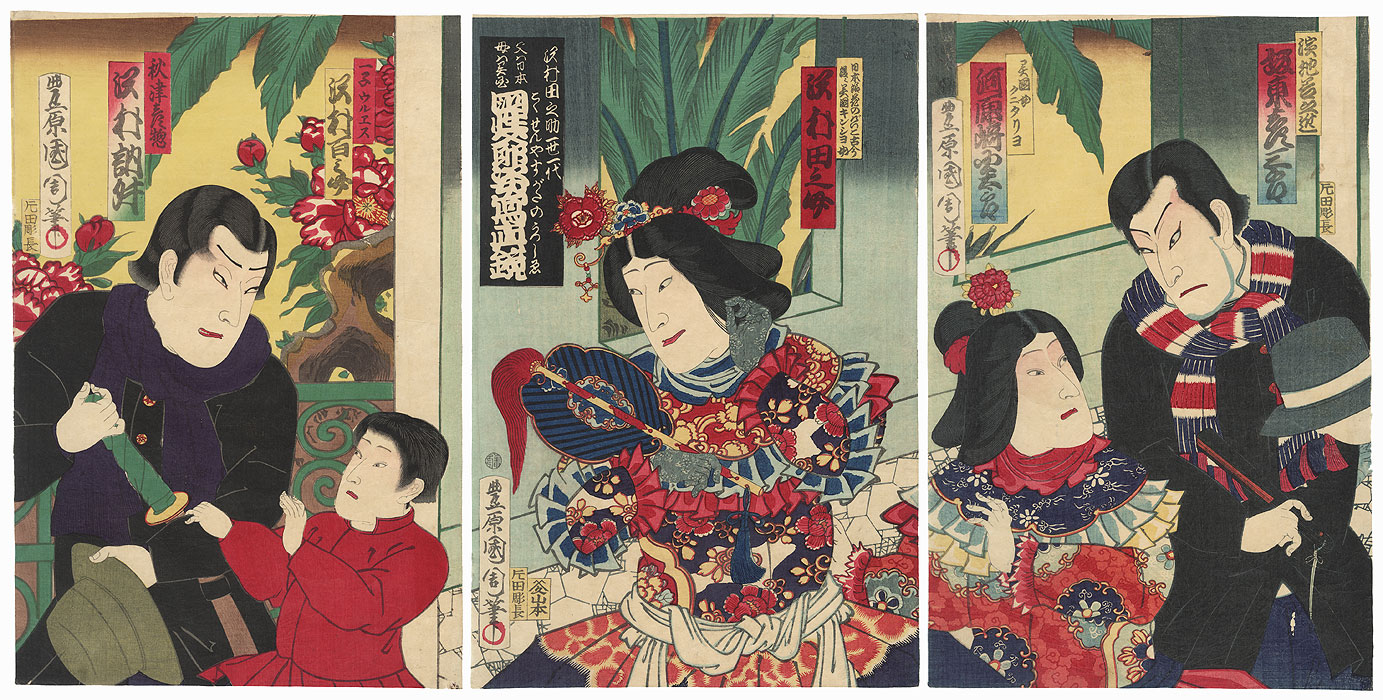Toyohara Kunichika was, by any standards, something of a character.
The son of a tattooed bath house proprietor who was bankrupted and dishonoured, the young Kunichika was said to have been gifted with both a melodious voice and a talent for dance. Perhaps it was these attributes that drew him, as an adult, to the stage doors of Edo’s (the present-day Tokyo) popular Kabuki theatres, where he was to develop a reputation as a womaniser and a drunk, not averse to ending his evenings in the company of geishas and sex workers. Born a century later, and in a different island nation, he’d hardly have been out of place in the Soho of the 1960s.
 All of which would be by-the-by if not for the talent and craft he applied to his work. Apprenticed at the age of 13 to the great Utagawa Kunisada – the pre-eminent woodblock print artist of his time – he arguably went on to inherit this mantle following his death. In the process, he straddled the transition from the Edo to the Meiji eras in Japan; a period of rapid upheaval in which the traditions of a feudal society were supplanted by the process of industrialisation, following the country’s opening up to Western influence. In particular, he was forced to live up to the challenges posed to his craft by the new technologies of photography and photo engraving.
All of which would be by-the-by if not for the talent and craft he applied to his work. Apprenticed at the age of 13 to the great Utagawa Kunisada – the pre-eminent woodblock print artist of his time – he arguably went on to inherit this mantle following his death. In the process, he straddled the transition from the Edo to the Meiji eras in Japan; a period of rapid upheaval in which the traditions of a feudal society were supplanted by the process of industrialisation, following the country’s opening up to Western influence. In particular, he was forced to live up to the challenges posed to his craft by the new technologies of photography and photo engraving.
This beautifully mounted exhibition at the Lady Lever Art Gallery in the Wirral separates his works thematically, displaying the prints at eye level against walls slabbed in a single colour, complementing the dyes Kunichika adopted in his printing process. Above the prints themselves, enlarged details add understated emphasis to the skill of his draughtsmanship, inviting the viewer to look closer.
It opens with a selection of works with which his name is probably most closely associated: Yakusha-e, prints portraying Kabuki actors, often in scenes from the plays they starred in. One of his more frequent subjects, Onoe Kikugoro V, was even to become a friend of his. Working typically on single sheets or across a triptych, Kunichika excels in capturing his subjects’ expressiveness, not only in their faces but also in the moment he hits upon to best suggest their feelings. Bodies are poised on the cusp of motion, be it languid or ferocious, in a way that anticipates the depiction of action in present-day Manga.
Often this leads to a wonderful economy of gesture, relating a story in just one apposite image as in the exact skewed angle at which the titular arsonist bites her handkerchief, failing to repress the flames of her ardour for the monk forbidden to her in Love Crazed Ashichi. At other times, there is a sense of narrative progression across an apparently static triptych, foreshadowing the way that panels came to signify the segmentation of time in sequential art. 
Exquisite though his compositions are, it should nonetheless be borne in mind that these are works informed in no small part by commercial imperatives. A series of prints of actors in restaurants incorporates an early example of product placement, for instance, while triptychs depicting the public lives of the Imperial household would presumably have catered to the 19th century Japanese equivalent to the readers of Hello! magazine. Adopting a more salacious perspective akin to our own Sunday tabloids are the works offering reproductions of Dokufu, the so-called ‘poison women’, sexually liberated femmes fatales who had been convicted of murdering men including the memorably headlined Seven Evil Women.
Whether as a window to an Eastern society accelerating towards the 20th century or an overview of a graphic craftsman at the peak of his powers, this is all but essential fare, well worth the short Merseyrail hop out to the eerily sedate Port Sunlight whose village-like ambience is an experience in itself.
Images: copyrighted to National Museums Liverpool, courtesy of Frank Milner
Kunichika: Japanese Prints is at the Lady Lever Art Gallery until September 4, 2022. For more information, click here.











